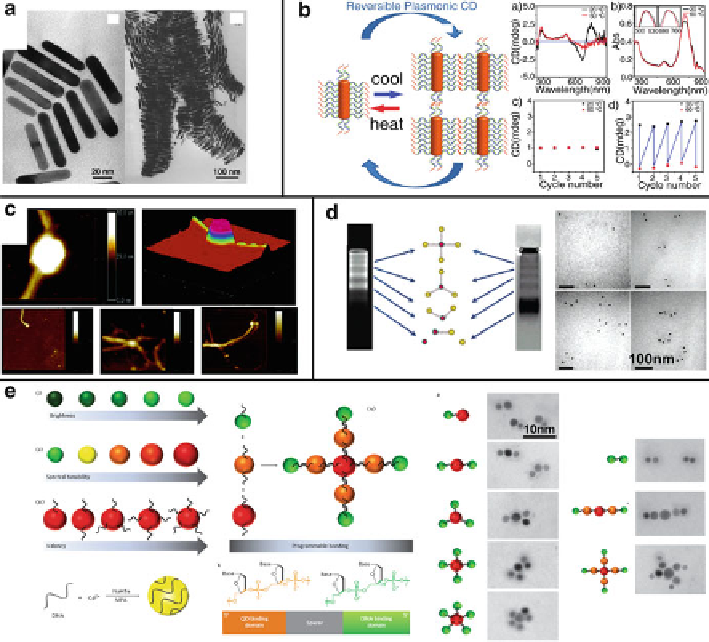Biomedical Engineering Reference
In-Depth Information
Fig. 9.3
DNA as a link for other NP self-assembly. (
a
) TEM of bundles of DNA-linked gold
nanorods. (
b
) Scheme of reversible plasmonic CD responses based on dynamic assembly and
disassembly of double-strand DNA-modified Au NRs (
yellow column
) at different temperature and
reversible plasmonic CD signal. (
c
) Typical AFM images of the self-assembly of ssDNA-MWNTs
and cDNA-Au nanoparticle. (
d
) Gel electrophoresis migration pattern of QD/Au nanostructures.
The same gel is illuminated under UV (to see QDs by fluorescence,
left panel
) and under white
light (to represent Au through absorption,
right panel
); the
right
shows the TEM images of
discrete nanostructures of QDs/Au extracted from corresponding bands after gel electrophoresis.
Scale bar is 100 nm. (
e
) Synthetic strategy for the development of quantum dots exhibiting
strong luminescence, tunable emission spectrum, programmable valency and highly controllable
binding energy, and corresponding TEM image at the right section. Scale bar is 10 nm (Part
(
a
) reproduced from Ref. [
24
] with permission of The Royal Society of Chemistry. Part (
b
)
reprinted with permission from Ref. [
25
]. Copyright 2012 American Chemical Society. Part
(
c
) reprinted with permission from Ref. [
26
]. Copyright 2005 American Chemical Society. Part
(
d
) reprinted with permission from Ref. [
27
]. Copyright 2004 American Chemical Society.
Part (
e
) reprinted with permission from Macmillan Publishers Ltd: Ref. [
28
], copyright 2011)
(Fig.
9.3
b) [
25
]. Dai et al. created DNA-directed self-assembly of carbon nanotubes
and AuNPs into multicomponent structures by using double-stranded DNA linker
(Fig.
9.3
c) [
26
]. Besides, quantum dots (QDs) were also employed as building
blocks for DNA-directed self-assembly. Alivisatos' group first prepared discrete

Search WWH ::

Custom Search